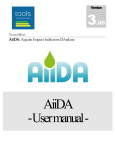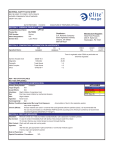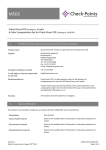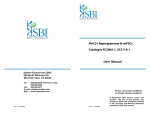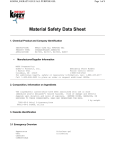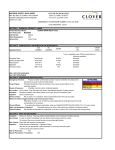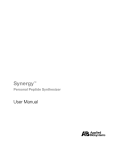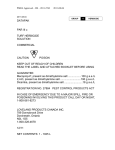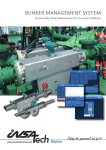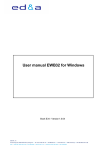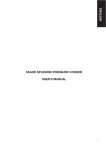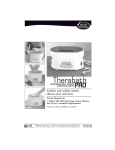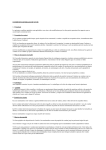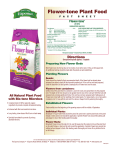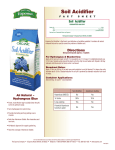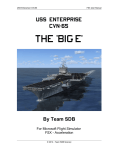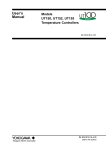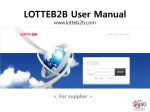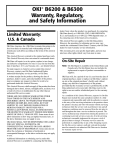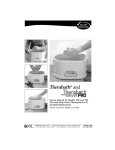Download SSEA PP & PE CONTAINMENT NET USER MANUAL
Transcript
SPECIALISED SAFETY EQUIPMENT AUSTRALIA SSEA PP & PE CONTAINMENT NET USER MANUAL At the present time SSEA has available two different types of load containment nets. The products are PP…Polypropylene and PE…Polyethylene. PP has a strand appearance and is knotted at the corners and is blue in colour; on the other hand PE has a woven/knitted appearance and is woven/knitted in the corners and is green in colour. The net is available in a range of popular sizes and can be custom made upon request. CARE AND MAINTENANCE Whilst the product is very robust has excellent load containment properties simple care and maintenance should be exercised to ensure trouble free use. DO NOT X Allow net to come in contact with solvents, petrol, diesel, glue, paint and the like. X Allow net to be tensioned excessively over sharp objects. X Allow net to flap…nets are flap resistant but need to be correctly fastened. X Leave net on vehicle for extended periods when not in use. X Expect the net to replace approved methods of load restraint. See diagram figure 1 in this manual. X Use for containing livestock or any animal. DO Wash when needed in preferably a Ph neutral detergent and water. E.g. Morning fresh and rinse well. Hang in shade and allow to dry before packing for storage. Keep away from extreme temperatures. Use packing, eg carpet or similar to protect against cutting and excess abrasion. Use an adequate number of tie downs to eliminate your load escaping. Remember you as the operator are ultimately responsible for your load restraint and containment. Form SSEAQA LCN Net User Manual Revision 1 30/03/2011 Page 1 of 11 SPECIALISED SAFETY EQUIPMENT AUSTRALIA X Form SSEAQA LCN Net User Manual Revision 1 30/03/2011 Page 2 of 11 SPECIALISED SAFETY EQUIPMENT AUSTRALIA Figure 1: The following diagram may assist you in understanding load restraint obligations, prior to using a SSEA PP or PE Load Containment Net. Please be aware that this product offers excellent containment properties but DOES NOT exempt the use of adequate approved restraint methods. Product must be replaced if: Any signs of deterioration (tear, abrasion, cut etc) are visually identifiable, or 12 months has lapsed from the date of first use, or Any part of the product has been in contact with solvents, petrol, diesel, glue, paint and the like. Form SSEAQA LCN Net User Manual Revision 1 30/03/2011 Page 3 of 11 SPECIALISED SAFETY EQUIPMENT AUSTRALIA 01 Form SSEAQA LCN Net User Manual Revision 1 30/03/2011 Page 4 of 11 SPECIALISED SAFETY EQUIPMENT AUSTRALIA 01 Form SSEAQA LCN Net User Manual Revision 1 30/03/2011 Page 5 of 11 SPECIALISED SAFETY EQUIPMENT AUSTRALIA 01 Form SSEAQA LCN Net User Manual Revision 1 30/03/2011 Page 6 of 11 SPECIALISED SAFETY EQUIPMENT AUSTRALIA 01 Form SSEAQA LCN Net User Manual Revision 1 30/03/2011 Page 7 of 11 SPECIALISED SAFETY EQUIPMENT AUSTRALIA Honam Petrochemical Corp. Lotte Tower B/D (9~11F), 359-67, Shindaebang-dong, Dongjak-gu, Seoul, Korea Tel) 02-829-4114 Fax) 02-843-1010 Homepage) www.hpc.co.kr File No MSDS-PE-UT404 Issue Data 2009.02.01 Polyethylene Revision Data 01 (PE) Page 8/11 Material Safety Data Sheet SECTION 1. CHEMICAL PRODUCT AND COMPANY IDENTIFICATION 1) Product Name: Linear Low Density Polyethylene, GRADE: UT404 2) Company Identification ① Prepared by: Honam Petrochemical Corp. Daesan Plant ② Address: 634 Dokgot-Ri, Daesan-Eup, Seosan-city, Chungnam, Korea ③ Telephone & Fax: Tel) 82-61-689-5830, Fax) 82-61-689-5993 ④ Revision Date: 2009.02.01 SECTION 2. COMPOSITION / INFORMATION ON INGREDIENTS Component Ethylene Polymer Additives CAS No 25087-34-7 - Composition (%) Min 99 Max 1 SECTION 3. HAZARDS IDENTIFICATION 1) Appearance: White 2) Eye Contact: Product fines can cause mechanical irritation. 3) Skin Contact: Product is unlikely to cause irritation. 4) Inhalation: Product fines may cause mechanical irritation. 5) Ingestion: Product is practically non-toxic. 6) Signs and Symptoms: Irritation as noted above. SECTION 4. FIRST AID MEASURES 1) Eye Contact: Flush eyes with water if irritation occurs. 2) Skin Contact: Flush skin with plenty of soap and water for at least 15 minutes, while removing contaminated clothing and shoes. 3) Ingestion: Do not induce vomiting. Allow the victim to rinse his mouth then to drink 2-4 cupfuls of water and seek medical advice. 4) Inhalation: Remove from exposure to fresh air immediately. 5) Notes to physician: Treat symptomatically and supportively. SECTION 5. FIRE-FIGHTING MEASURES 1) Flash Point and Method: Not Applicable Form SSEAQA LCN Net User Manual Revision 1 30/03/2011 Page 8 of 11 SPECIALISED SAFETY EQUIPMENT AUSTRALIA Honam Petrochemical Corp. Lotte Tower B/D (9~11F), 359-67, Shindaebang-dong, Dongjak-gu, Seoul, Korea Tel) 02-829-4114 Fax) 02-843-1010 Homepage) www.hpc.co.kr File No MSDS-PE-UT404 Issue Data 2009.02.01 Polyethylene Revision Data 01 (PE) Page 9/11 Material Safety Data Sheet 2) Extinguishing media: Use water fog, foam, dry chemical or CO2 3) Autoignition temperature: Not Applicable 4) Special fire fighting procedures and precautions: Material will not burn unless preheated. Do not enter confined fire space without full bunker gear(helmet with face shield, bunker coats, gloves and rubber boots). Cool fire exposed containers with water. 5) Unusual fire and explosion hazards: Treat as a solid that can burn. Molded parts generally burn slowly with a low smoke density and flaming drips. Under certain conditions can burn with a high smoke density. SECTION 6. ACCIDENTAL RELEASE MEASURES 1) General information: Use proper personal protective equipment 2) Spill/leaks: Clean up spills immediately. Sweep up, then place into a suitable container for disposal. SECTION 7. HANDLING AND STORAGE 1) Handling: Wash thoroughly after handling. Remove contaminated clothing and wash before reuse. Avoid contact with eyes, skin, and clothing. Avoid ingestion and inhalation. 2) Storage: Store in a cool, dry place. Keep container closed when not in use. SECTION 8. EXPOSURE CONTROLS / PERSONAL PROTECTION 1) Engineering controls: Use adequate general or local exhaust ventilation to keep airborne concentrations below the permissible exposure limits. Use process enclosure, local exhaust ventilation, or other engineering controls to control airborne levels. 2) Personal protective equipment ① Eye: Wear safety glasses and chemical goggles if splashing is possible. ② Skin: Wear appropriate protective gloves and clothing to prevent skin exposure. ③ Clothing: Wear appropriate protective clothing to minimize contact with skin. ④ Respirators: Use approved supplier air respiratory protection. Form SSEAQA LCN Net User Manual Revision 1 30/03/2011 Page 9 of 11 SPECIALISED SAFETY EQUIPMENT AUSTRALIA Honam Petrochemical Corp. Lotte Tower B/D (9~11F), 359-67, Shindaebang-dong, Dongjak-gu, Seoul, Korea Tel) 02-829-4114 Fax) 02-843-1010 Homepage) www.hpc.co.kr File No MSDS-PE-UT404 Issue Data 2009.02.01 Polyethylene Revision Data 01 (PE) Page 10/11 Material Safety Data Sheet SECTION 9. PHYSICAL AND CHEMICAL PROPERTIES 1) Appearance: White 2) Odor: Essentially odorless pellet. 3) pH: Not applicable 4) Solubility: (In Water) Insoluble (Other solvent) Soluble in Tetrahydronaphthalene, Tetrachloroethane etc. 5) Viscosity: Not applicable 6) Melt point: 100 ~ 130 ℃ 7) Boiling point: Not applicable 8) Decomposition temperature: Not applicable 9) Vapor pressure: Not applicable 10) Vapor density (air=1): Not applicable 11) Evaporation rate: Not applicable 12) Specific gravity (H2O=1): 0.910 ~ 0.945 13) Molecular weight: >10,000 SECTION 10. STABILITY AND REACTIVITY 1) Chemical stability: Stable under normal temperature and pressure 2) Conditions to avoid: Incompatible materials, strong oxidants 3) Incompatibilities with other materials: Strong oxidizing agents 4) Hazardous decomposition product: Carbon monoxide, irritating and toxic fumes and gases, carbon dioxide SECTION 11. TOXICOLOGICAL INFORMATION 1) LD50: 3200 mg/kg Mouse-in throat 2) Inhalation: Product fines may cause mechanical irritation. 3) Skin contact: Product is unlikely to cause irritation. 4) Eye contact: Product fines can cause mechanical irritation. 5) Ingestion: Product is practically non-toxic. Form SSEAQA LCN Net User Manual Revision 1 30/03/2011 Page 10 of 11 SPECIALISED SAFETY EQUIPMENT AUSTRALIA Honam Petrochemical Corp. Lotte Tower B/D (9~11F), 359-67, Shindaebang-dong, Dongjak-gu, Seoul, Korea Tel) 02-829-4114 Fax) 02-843-1010 Homepage) www.hpc.co.kr File No MSDS-PE-UT404 Issue Data 2009.02.01 Polyethylene Revision Data 01 (PE) Page 11/11 Material Safety Data Sheet SECTION 12. ECOLOGICAL INFORMATION 1) Spill or leak procedures: Shovel and sweep up or use industrial vacuum cleaner. Avoid generation dust clouds. Put into containers for reclaiming or disposal. 2) Ecotoxicity: Not applicable SECTION 13. DISPOSAL CONSIDERATIONS 1) Waste disposal method: Place contaminated material in disposable containers and dispose of in a manner consistent with applicable regulations. Contact local environmental or health authorities for approved disposal of this material. 2) Environmental hazards: Not applicable SECTION 14. TRANSPORTATION REQUIREMENTS Not applicable SECTION 15. REGULATORY INFORMATION 1) Korea: Not applicable 2) US Federal: The components of this product are listed on the SARA and TSCA inventory of chemical substances. SECTION 16. ADDITIONAL INFORMATION The information contained herein is believed to be accurate and represents the best information currently available to us. However, we make no warranty of merchantability or any other warranty, express of implied, with respect to such information, and we assume no liability resulting from its use. Therefore, vendee assumes the risk in his use of the material. Form SSEAQA LCN Net User Manual Revision 1 30/03/2011 Page 11 of 11











